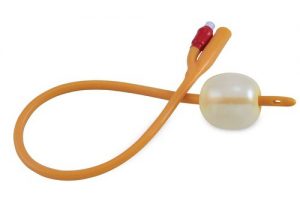Most of the time, your body uses internal cues to determine when you and the baby are ready to meet face-to-face, and you’ll go into labor on your own. In some other cases, your doctor may suggest medical intervention to help get things moving. One way to jump-start labor is a Foley balloon catheter induction.
How Does Foley Balloon Catheter Induction Work?
If you’re considering a Foley balloon (or Foley bulb) induction, here’s what to expect:
- The doctor may begin by monitoring the baby’s heart rate for about 20 minutes to make sure he or she is stable, and check that the baby is positioned head-down.
- You lie back with your feet in stirrups.
- The doctor inserts a thin, flexible tube with a deflated balloon on it into your cervix using forceps.
- The doctor fills the balloon with a small amount of sterile solution to inflate it.
- The expanding balloon pushes against your cervical opening to help it dilate. The procedure may also make your cervical tissue more reactive to hormones like oxytocin and prostaglandins, which play a role in stimulating labor.
- The doctor may add more solution as needed as time goes on.
- The balloon should fall out on its own once you’re about 3 cm dilated.
Your doctor may suggest using this method on its own, or may apply medication to your cervix as an additional means of stimulating contractions and dilation.
When Would My Doctor Recommend Foley Induction?
Medical providers may recommend induction in a number of situations. A few possibilities could be:
- You’re post-term (41-42 weeks, depending on the provider)
- The baby doesn’t appear to be growing the way he or she should, and doctors think birth would help
- You have a complication like high blood pressure or gestational diabetes, and doctors think delivering the baby is the best choice for your health
- Your water broke, but you’re not having contractions yet
Does a Foley Induction Hurt?
Here’s the thing: Any induction method is intended to get you into full-blown labor, so in a way, some pain is part of the goal! Many expectant parents are anxious about how they’ll cope with the pain of labor, so let’s talk a little about what to prepare for with a Foley balloon induction.
Beginning the induction procedure is essentially the start of labor (if all goes according to plan), so now’s the time to get into that frame of mind. If medical pain relief is part of your birth plan, remind your doctor, and ask when that would be available so you know how long to expect to feel contractions. If you’re aiming for an unmedicated birth, break out the comfort measures you’ve practiced, like visualization, music, or breathing exercises.
The actual induction part can range from “discomfort” to pain, depending how your body reacts. Generally, especially if you’re having the Foley balloon induction without other medication, it shouldn’t cause stronger or more painful contractions than spontaneous labor.
Benefits and Risks of Foley Catheter Induction
One of the reasons doctors may recommend a Foley catheter induction is that it carries very low risk for you and the baby. A meta-analysis of over 8,000 women found that the estimated rate of “adverse events” was about 0-0.26%, with pain and discomfort being the most frequently reported risk.
Your doctor will talk you through the rates of risk in your case, but overall this is considered a safe procedure for you and the baby. In some cases, depending on your provider and the health of your baby and pregnancy, doctors may consider Foley catheter induction as an option for patients attempting a vaginal birth after cesarean (VBAC) section. You should keep in mind that just about any intervention, including this method of induction, carries a lower rate of VBAC success than going into labor on your own.
One other potential risk is if the induction doesn’t work. Some people’s bodies aren’t as responsive to attempts to start labor artificially. In that case, your doctor will likely suggest another means of labor induction or augmentation, such as Pitocin, or you may need a C-section.
Meanwhile, the benefits of a Foley catheter induction include:
- Low cost
- Low risk to parent and baby
- Simple and easy for many providers to do
- Can eliminate need for medication like Pitocin, or can make the cervix more responsive to medications if they’re still warranted
- Less likely to cause fetal distress than some other methods of induction
- Sometimes considered a safe option for patients attempting a VBAC
Always ask your provider any questions you need to make an informed choice about your care, and get ready to meet your baby soon!

